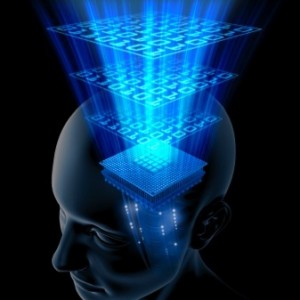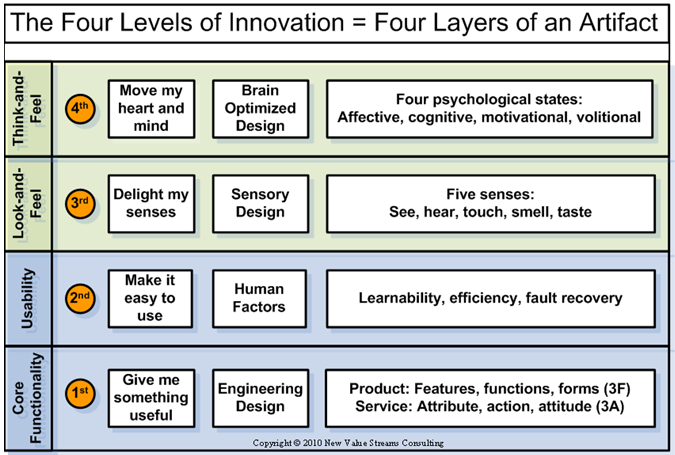What is an artifact? Why should you care?
Artifacts are what designers and innovators create. How you think about them determines how creative you will be.
 Artifacts are those abstractions, objects and activities that are designed for a specific purpose. They are the stuff and events created by people rather than nature. In general terms artifacts are a collection of four levels of overlapping features and functions with a distinct form that have been designed to:
Artifacts are those abstractions, objects and activities that are designed for a specific purpose. They are the stuff and events created by people rather than nature. In general terms artifacts are a collection of four levels of overlapping features and functions with a distinct form that have been designed to:
- Be useful or deliver the core functionality of the artifact (level 1)
- Be easy to access or give the artifact usability (level 2)
- Delight senses or give the artifact a look-and-feel (level 3)
- Move hearts/minds or give the artifact a think-and-feel (level 4)
Take the radio for example. It is useful because it has been engineered to play music. Playing music, news and other audio broadcasts is the radio’s core function. Most modern radios have digital displays, scan features and memory buttons that make them very easy to use. These features give radios usability. Some radios are almost a work of art in the way they stimulate our visual and tactile senses with a sleek high-tech form, diode illuminated displays and grip-right buttons. Whereas other radios are plain in appearance and sensory experience and deemphasize features at level three.
The level four effects of a radio are pronounced. The music produced by radios naturally stirs our emotions and thoughts. The core functionality of a radio causes psychological impact. A radio’s design can tug on our heart (e.g. old radios or those with retro designs can cause us to reminisce) or extend our minds by delivering news or including built in alarms to act as memory aids.
The traditional radio and other personal music-playing devices have recently experienced rapid innovation, standouts being the iPod and satellite radio services. These innovations can be understood as the addition or deletion of features and functions to drive usefulness, usability, look-and-feel or move our hearts and minds with a think-and-feel experience. Indeed, this is true of not just personal music playing consumer electronics but all innovations including services, industrial improvements and social advances.
Everything that improves from the drive-thru experience at a quick server restaurant, to the computers that run a global bank and even light bulbs are all being reshaped to be more useful, usable and have a more tailored impact on your senses, emotions and thoughts.
All artifacts, or those things we design for a specific purpose, can be innovated at four fairly distinct levels.
We can add, change or delete features and functions at:
- Level one to change their purpose or core utility and usefulness
- Level two to make them easier to find, learn, use and maintain
- Level three to heighten or extend the positive impact they have on our five senses
- Level four to authentically move heart, extend mind or enrich psychology.
These four levels of innovation are supported by specific disciplines including engineering design at level one, user experience studies and human factors at level two, industrial design, graphic design and sensory design at level three and experience design, cognitive engineering and other areas dedicated to brain-optimized design at level four.
There are four layers in every artifact affording the opportunity to do four levels of innovation as summarized in the diagram below.
The blue versus green shading in the diagram illustrates a shift in focus from the artifact as an object to the artifact as a human experience. Layers three and four are based primarily on mental states and layers one and two are based on the science and engineering of the object. An artifact is different from an object precisely because it includes all four layers. The mental states that make up the experience are just as much part of the artifact as materials, electronics and software are. An object becomes an artifact when it is experienced.
Historically speaking most innovation efforts have focused on levels one and two. The emphasis was, and still mostly is, on the science, engineering and design of atoms and bits. Now the basis of innovation is shifting to emphasize levels three and four. As Pine and Gilmore point out in their newly updated book, The Experience Economy, value creation moves through a progression from extracting commodities and making products to delivering services and finally staging experiences and personal transformation.
Commodity –> Product –> Service –> Experience –> Personal Transformation
Take chicken for example. Growing chickens on the farm extracts a basic commodity from nature. Chicken is packaged and sold in grocery stores as a product. Many restaurants and even several dedicated chains offer chicken items on the menu and in essence delver a chicken cooking service. Organizations such as Medieval Times serve only chicken but use it to help stage dinning experiences that involves live-action knights, jousting contests and even damsels in distress. Patrons are transported back in time as they sit around a real horse arena eating chicken with their hands and cheer fully armored knight-actors as they play out a number of very realistic scenarios. Finally, organizations that fight against cruelty to animals could create a short film contrasting adorable chicks to the practices at meat processing facilities. Such films are often designed to create personal transformations in viewers.
As you move up the value progression from commodity to experience and personal transformation, the role of sensory and psychological impact in creating that value increases dramatically. Likewise the types of sciences you draw on to innovate systematically change dramatically to refocus on neuroscience, cognitive science, psychology, experimental philosophy and other disciplines the seek an empirical understanding of how to stage or create experiences based on how our minds really work.
Staging experiences or more precisely creating a series of mental states for customers that meet a deeply felt psychological need can make all the difference in market share and price. For example, many companies produced low-cost MP3 players but it was Apple that added key features to MP3 technology to create a personal music experience. These features had more to do ease of use, sensory delight and psychological impact. Apple gain more share and charged higher prices than others in the market. They did this not though superior skills in electrical engineering, materials or computer programming but by developing a deep insights into how the minds of their customers work.
The scientific foundation for innovation is shifting from a focus on atoms, materials and computers to one that also includes neurons and mental states.
Experience is an important source of value. You create experience value by meeting deeply felt psychological needs. While it is beyond the scope of our discussion to survey the latest thinking about how our minds work, it is important to have a general understanding of the four basics psychological states that make up experience value. These include:
- Affective or having to do with emotion, mood and feeling.
- Cognitive or have to do with memory and so-called intellectual processes such as decision-making, problem solving and learning.
- Volition or having to do with self determination, free will and personal choice.
- Motivation or having to with level of commitment to a goal or action.
Just as our five senses mix together to give us a picture of the world, these four psychological states mix together to make up the value we assign as we experience the world. In short, they create a think-and-feel.
For more examples see Think-and-Feel: The Fourth Level of Innovation and Comfortable Control.

February 1st, 2014 at 9:06 pm
reverse phone lookup free…
The paid Reverse Cell phone lookup provide and maintain a rich directory that includes addresses and other necessary details adequate enough to turn you to a celebrated detective overnight….
February 1st, 2014 at 10:43 pm
https://archive.org/details/PhoneNumberReverseLookup…
You stare hard at it but it doesn’t ring a bell and you are not sure if it is familiar or not….
February 2nd, 2014 at 1:49 am
reverse phone lookup white pages website…
So if the owner of the number you are looking for has shared his cell phone number and identity voluntarily, you will get it there….